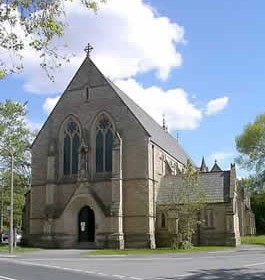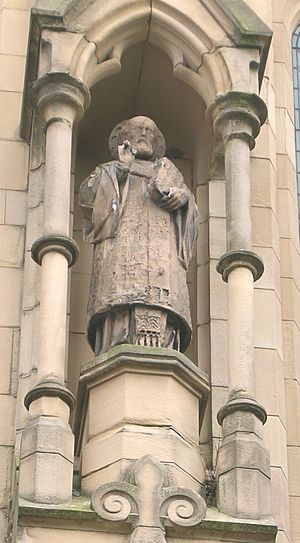St Chrysostom's Church, Victoria Park facts for kids
Quick facts for kids St Chrysostom's Church |
|
|---|---|

St Chrysostom's seen from the northwest
|
|
| Location | Victoria Park, Manchester |
| Country | England |
| Denomination | Church of England |
| Churchmanship | Anglo-Catholic |
| History | |
| Status | Parish church |
| Consecrated | 13 October 1877 |
| Architecture | |
| Functional status | Active |
| Heritage designation | Grade II listed |
| Architect(s) | George Tunstal Redmayne |
| Administration | |
| Deanery | Manchester North & East |
| Archdeaconry | Manchester |
| Diocese | Manchester |
| Province | York |
Saint Chrysostom's Church is a Church of England church located in Victoria Park, England. It is a "parish church," which means it serves a specific local area. The church follows the Anglo-Catholic tradition, which is a style of worship within the Church of England that has some similarities to Roman Catholic practices. It is also known for being a welcoming place for everyone.
The church is named after Saint John Chrysostom, an important early Christian leader. There are only three churches in the Church of England dedicated to him, and this is one of them! St Chrysostom's Church is part of the Diocese of Manchester and the Province of York.
Contents
Discovering St Chrysostom's History
The Church's Local Area
The area that St Chrysostom's Church serves is quite large. It stretches from Dickenson Road to Plymouth Grove and includes parts of Rusholme, Longsight, and all of Victoria Park. Many important places are in this area, such as St Mary's Hospital, Victoria Baths, the Chinese Consulate, Longsight Market, and a big part of the famous Curry Mile.
Victoria Park itself was once part of another church's area until 1878. That's when St Chrysostom's got its own parish.
Victoria Park: A Special Place
In 1836, a unique project began in Victoria Park. Architects like Richard Lane planned a special neighborhood with large houses and spacious gardens. Wealthy business people and professionals could live there. Lane was known for his grand public buildings.
By 1850, about 50 houses had been built by different architects. Victoria Park features buildings by famous architects like Alfred Waterhouse and George Tunstal Redmayne, who also designed St Chrysostom's.
Many well-known people lived in Victoria Park during the 1800s. These included politicians like Richard Cobden and George Hadfield, the musician Sir Charles Hallé, artist Ford Madox Brown, and the Pankhurst family, who were important for women's rights.
A church was planned for Victoria Park as early as 1836. However, the first attempt to build it in the 1840s stopped because the company behind Victoria Park went bankrupt.
The Church Building: A Closer Look
Building and Rebuilding
The church was designed by George Tunstal Redmayne in an early English style. Construction took place between 1874 and 1876, costing about £13,000. It was officially opened and blessed by the Bishop of Manchester on October 13, 1877.
Sadly, a fire badly damaged the inside of the church on October 1, 1904. People thought it might have been caused by the new electricity system, but this was never proven. Rebuilding started under architect John Ely. The church was rebuilt almost exactly as Redmayne had designed it.
While the church was being rebuilt, the congregation met in a temporary "iron church" nearby. So, the church you see today, both inside and out, is mostly the rebuilt version from 1906. It is a "Grade II listed" building, meaning it's an important historical structure.
Even though the area around the church has changed a lot over the years, the church itself has remained much the same. It stands out in Victoria Park and is an important part of the community.
Beautiful Stained Glass Windows
Most of the church's windows are made of stunning stained glass. They were created by artists Burlison and Grylls, who were inspired by the Pre-Raphaelite art style. The windows in the main part of the church and near the altar have a similar look. They feature pale, detailed designs, dark robes, and rich, bright colors.
Many windows show saints from the British Isles or important church teachers. These include St Augustine, St Ambrose, St Paulinus, St Hilda, the Venerable Bede, and St Patrick. There are also windows honoring John Keble and Edward Pusey, who were key figures in the Anglo-Catholic movement. In the chancel (the area around the altar), there are windows for important Latin and Greek church leaders like Ambrose, Chrysostom, Athanasius, and Augustine.
The windows are full of small details, like family symbols and monograms. Some War Memorial windows even include reproductions of photographs. The window of St John Chrysostom in the chancel is special; it shows the church's patron saint holding a model of the church itself. Some windows in the Anson Chapel were made by a local Manchester artist, Walter Pearce. These have a different style and use of color. One window remembers major battles from the First World War. There is also a round stained glass window with angels in a beautiful art deco style.
Stations of the Cross
The Stations of the Cross are a set of images or sculptures that show Jesus's journey to his crucifixion. These were added to the church later, around 1938. They were created by Ian Howgate, who worked with a group called the Faith Craft studio.
Remembering Heroes: The War Memorial
The church has a special War Memorial in the Anson Chapel. It is made of wooden panels and was designed by P A Robson. The plaques with names were made by Miss E Attwood. A large granite slab was also placed outside the church's main door to mark the memorial.
The memorial was finished in 1923 and was officially dedicated on Sunday, May 13. Two years later, two stained glass windows were added to the Anson Chapel. These windows were a gift from J. S. Williamson and were made by Walter J. Pearce. They were dedicated on November 15, 1925.
After the Second World War, the names of those who died in that war were added to the memorial on two new panels.
The Church Leaders
The first priest to lead St Chrysostom's as its rector was Father William Marsden. He started in 1877 and served the church for a long time, until 1899. Father Marsden helped shape the church's traditions.
Today, the Parish Priest is Father Lee David Wood.
The Church Organ
The church's organ was built in 1906 because the original organ was destroyed in the 1904 fire. It is located on the north side of the choir area. The organ was built by William Hill & Son, a famous organ builder.
The organ is used for church services, concerts, and recitals. In 2006, it received a special certificate, a Historic Organ Certificate Grade II*, from the British Institute of Organ Studies. This means it's a very important historical instrument.
Only a few small changes have been made to the organ since 1906. It is still a high-quality instrument, and its sound is much like it was when it was first built. However, the choir organ was damaged by water in 1998 and needs repair. The whole instrument is also over 100 years old and needs a major restoration to keep it in good condition.
See also
- Listed buildings in Manchester-M14


